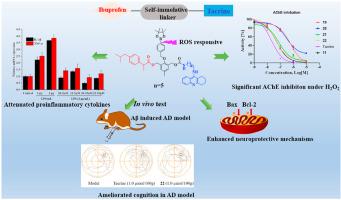European Journal of Medicinal Chemistry ( IF 6.0 ) Pub Date : 2020-11-06 , DOI: 10.1016/j.ejmech.2020.112997 Zhikun Liu , Bin Zhang , Shengjin Xia , Lei Fang , Shaohua Gou

|
Current drugs available in clinic for Alzheimer’s disease (AD) treatment can only alleviate disease symptoms without clearly curing or delaying the process of AD. And some AD drugs failed in Phase III clinical trials are only focused on targeting amyloid-β (Aβ). Therefore, an alternative strategy in AD drug design is meaningful to be involved in the multiple pathogenic factors which can affect each other at multiple levels. Herein, we report a series of ROS-responsive prodrugs based on multi-target-directed ligands (MTDLs) approach, which can specifically release tacrine derivatives and ibuprofen under oxidation of ROS and show acetylcholinesterase (AChE)-inhibiting, neuron-protective and anti-inflammatory effects in extracellular or intracellular assays. Related biological study illustrated that compound 22 was able to permeate blood-brain-barrier (BBB) showing little hepatotoxicity in comparison to tacrine. Besides, 22 hinted a therapeutic clue in AD-treatment by regulating proinflammatory factors (IL-1β and TNF-α) and apoptosis related proteins (Bax, Bcl-2 and cleaved caspase-3). Further spatial memory assays in Aβ-induced AD model showed that 22 enhanced the ability of learning and memory. Our study proves that the strategy of ROS-responsive prodrugs has promise for AD treatments in future and offers a way for AD drug development.
中文翻译:

ROS响应和多功能抗阿尔茨海默氏症前药:他克林-布洛芬杂合体通过苯基硼酸酯连接子。
临床上可用于阿尔茨海默氏病(AD)治疗的现有药物只能缓解疾病症状,而不能明确治愈或延迟AD的进程。而且一些在III期临床试验中失败的AD药物仅专注于靶向淀粉样β(Aβ)。因此,AD药物设计中的替代策略对于涉及可能在多个水平上相互影响的多种致病因素是有意义的。在本文中,我们报告了一系列基于多目标定向配体(MTDLs)方法的ROS响应前药,它们可以在ROS氧化下特异性释放他克林衍生物和布洛芬,并显示出抑制乙酰胆碱酯酶(AChE),保护神经元和抗乙酰胆碱酯酶的作用。 -细胞外或细胞内测定的炎症反应。相关生物学研究表明化合物22能够渗透血脑屏障(BBB),与他克林相比几乎没有肝毒性。此外,22提示通过调节促炎因子(IL-1β和TNF-α)和凋亡相关蛋白(Bax,Bcl-2和裂解的caspase-3)来提示AD治疗的治疗线索。在Aβ诱导的AD模型中进一步的空间记忆测定表明22增强了学习和记忆的能力。我们的研究证明,ROS反应性前药的策略有望在将来用于AD治疗,并为AD药物开发提供一种方法。











































 京公网安备 11010802027423号
京公网安备 11010802027423号